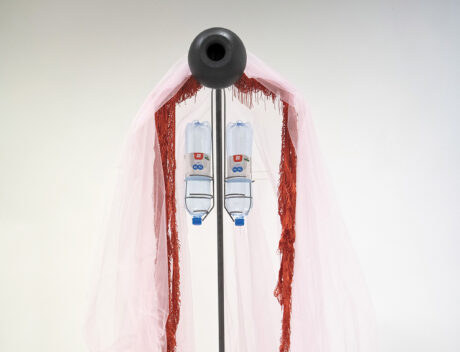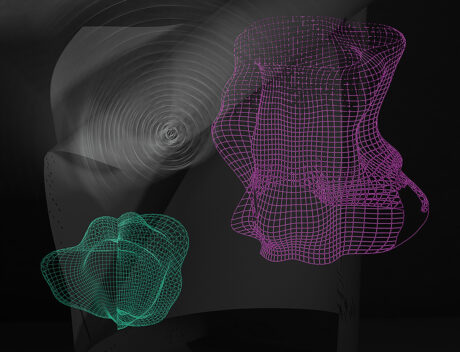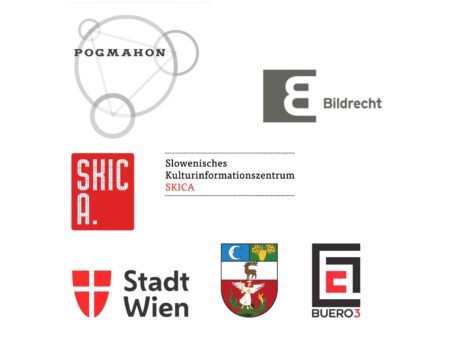Who wanna live forever
an Art & Science Exchange between Austria & Slovenia
with
Paula Flores * Anna Lerchbaumer *
Zoran Srdić Janežič * Tilen Žbona
Curated by Jiři Kočica & Denise Parizek
Opening: 4. Juli, 2024 um 18:00 hr
exhibition duration: 4. – 25. Juli, 2024
open for visitors:
9.07 von 18:00 bis 20:00
11.07 von 18:00 bis 20:00
13.07 von 10:00 bis 12:00
18.07 von 18:00 bis 20:00
Free entrance
„Who Wanna Live Forever“ is a unique collaboration featuring Vienna-based artists Paula Flores and Anna Lerchbaumer, along with Zoran Srdić Janežič and Tilen Žbona from Koper and Ljubljana, Slovenia. The project is curated by Denise Parizek (AT) and Jiři Kočica (SI).
The artists explore themes such as demographic change, the aging population, Dorian Gray syndrome, cosmism, life in the age of AI, genetic engineering, and migration. These themes are examined through both daily life in Central Europe and broader global perspectives. The exhibition will debut in Vienna in 2024 and subsequently be showcased in Ljubljana and Koper in 2025.
This exhibition reveals how art and science intersect to reflect humanity’s quest for eternal life. It promises a thought-provoking and engaging experience.
„Who Wanna Live Forever“ highlights issues like demographic change, aging, Dorian Gray syndrome, cosmism, AI, genetic engineering, and migration. The exhibition demonstrates how these topics impact both everyday life in Central Europe and the global community. It features artistic interpretations of scientific processes, performative experiments, and guided tours. Central to the exhibition is the human quest for immortality, explored through historical myths and modern scientific advancements. The aim is to provoke thought and inspire new perspectives on these complex subjects.
This project is supported by the Slowenisches Kulturinformationszentrum SKICA, Bildrecht and eindorf Kunstraum.
DE
„Who Wanna Live Forever“ ist eine einzigartige Zusammenarbeit zwischen den in Wien ansässigen Künstlerinnen Paula Flores und Anna Lerchbaumer sowie Zoran Srdić Janežič und Tilen Žbona aus Koper und Ljubljana, Slowenien. Das Projekt wird von Denise Parizek (AT) und Jiři Kočica (SI) kuratiert.
Die Künstlerinnen und Künstler erforschen Themen wie demografischen Wandel, die alternde Bevölkerung, das Dorian-Gray-Syndrom, Kosmismus, Leben im Zeitalter der KI, Gentechnik und Migration. Diese Themen werden sowohl durch das tägliche Leben in Mitteleuropa als auch aus einer globalen Perspektive betrachtet. Die Ausstellung wird 2024 in Wien eröffnet und anschließend 2025 in Ljubljana und Koper gezeigt.
Diese Ausstellung zeigt, wie Kunst und Wissenschaft zusammenkommen, um die menschliche Suche nach ewigem Leben zu reflektieren. Sie verspricht ein nachdenklich stimmendes und fesselndes Erlebnis.
„Who Wanna Live Forever“ beleuchtet Themen wie demografischen Wandel, Alterung, Dorian-Gray-Syndrom, Kosmismus, KI, Gentechnik und Migration. Die Ausstellung demonstriert, wie diese Themen sowohl das tägliche Leben in Mitteleuropa als auch die globale Gemeinschaft beeinflussen. Sie umfasst künstlerische Interpretationen wissenschaftlicher Prozesse, performative Experimente und geführte Touren. Im Mittelpunkt der Ausstellung steht die menschliche Suche nach Unsterblichkeit, die durch historische Mythen und moderne wissenschaftliche Fortschritte erforscht wird. Ziel ist es, zum Nachdenken anzuregen und neue Perspektiven auf diese komplexen Themen zu eröffnen.
Dieses Projekt wird unterstützt durch das Slowenische Kulturinformationszentrum SKICA, Bildrecht und den Kunstraum eindorf.
Image credits:
Anna Lerchbaumer, Zoran Srdić Janežič, Tilen Žbona
Who wanna live forever
text by Denise Parizek
Who wanna live forever is a bilateral project, a collaboration between two Art & Science graduates living in Vienna, Paula Flores and Anna Lerchbaumer, and two artists from the Art & Science Departments in Koper and Ljubljana, Slovenia. The project includes a show in Vienna 2024, eindorf 2024, as well as one in Ljubljana and Koper 2025.
The exhibition covers various topics – from demographic change, the ageing population, the Dorian Gray syndrome, cosmism, life in the age of AI, genetic engineering and migration. These themes manifest themselves both on the micro level of daily life in (Central European) countries and on the global macro level.
Artists search and wander through different systems, fields, different areas of human activity, they try to represent certain scientific processes symbolically, sometimes allegorically. Sometimes artists ‘speak’ with the language of Duchamp – they translate certain scientific processes directly into gallery spaces and make them available to the public’s interpretation. In doing so, they set in motion a rethinking or change of perspective in the viewer.
The presentation consists of 4 artistic positions, performative series of experiments for the audience and tours for adults and children guided by the artists.
A brochure on the topic will round off the project and be given to visitors.
One of the perspectives from which the problems are examined and from which certain solutions, proposals and ways of dealing with these issues emerge is the significantly increased interest of artists in science and in scientific findings or research. The language of art is thus constantly changing, growing, searching for ways and possibilities for action, developing models, theories and forming a language with which the problems of the modern world can be recognised and consequently also introduced into society as a proposal for new ways of self-organisation and self-reflection of social systems.
The myths of eternal youth and immortality run like a red thread through the centuries, from blood sacrifices, the blood countess, to Elon Musk’s fantasies of his eternity and the conspiracy theories during the Covid pandemic, which told of underground tunnel systems where children were locked up to vegetate as blood preserves.
Demographic forecasts in both Slovenia and Austria show that the ageing population cannot be halted by immigration alone. Birth rates are declining in both countries, and due to the problems of climate change and socio-political uncertainties, birth rates will not increase in the near future.
The desire for immortality is on the rise, especially in wealthy circles.
For example, Dorian Gray Syndrome (DGS), which refers to a cultural and social phenomenon characterised by a man’s extreme pride in his personal appearance and the fitness of his body, which is accompanied by difficulties in coping with the demands of psychological maturation and the ageing of his body. DGS is characterised by a triad of symptoms that overlap and thus combine diagnostic signs of dysmorphophobia, narcissistic traits and the immaturity of disturbed development.
The syndrome is mainly associated with white, affluent people who consume cosmetic products and services, hair growth products, sexual enhancers and cosmetic surgery.
Or stem cell therapy, in which stem cells are regenerated and re-injected into the body with the promise of improved organ function and rejuvenation.
The 19th century Russian philosopher Nikolai Fedorov, whose posthumously published text put forward the bold thesis that death was little more than a design flaw – a flaw that could be corrected by advances in science and technology. Fedorov also believed that this goal of correction – to achieve immortality – would unite social groups whose mutual fear of death had historically brought them together.
‘Our task,’ Fedorov wrote, ‘is to turn nature, the blind force of nature, into an instrument of universal revitalisation and to become a union of immortal beings.’
This visionary philosophical movement became known as Cosmism. It emerged during the Industrial Revolution – a time of unprecedented social change – and sought to redefine humanity’s relationship to technology and progress, with the ultimate goal of regulating the forces of nature so that humanity could achieve unity and immortality. The movement offered a more spiritual alternative to both Futurism and Communism.
Although interest in Russian Cosmism quickly faded, the movement has gained new life in the 21st century. It is perhaps even more relevant today than it was at the beginning of the 20th century. Fedorov and Svyatogor’s joint call for space colonisation to save humanity from earthly disasters, for example, is a direct parallel to Elon Musk’s promise to put humans on Mars.
The artists, curators and we also ask the audience why people long for eternal life and what they are prepared to do for it.
DE
Who wanna live forever ist ein bilaterales Projekt, eine Zusammenarbeit zweier in Wien lebender Art & Science Absolventinnen, Paula Flores und Anna Lerchbaumer und zwei Künstlern der Art & Science Departments in Koper und Ljubljana, Slowenien. Das Projekt beinhaltet eine Show in Wien 2024, eindorf 2024, sowie eine in Ljubljana und Koper 2025.
Die Ausstellung umfasst verschiedene Themen – vom demographischen Wandel, der Überalterung der Bevölkerung, dem Dorian Gray Syndrom, Cosmismus, dem Leben im Zeitalter von KI, Gentechnik, Migration. Diese Themen manifestieren sich sowohl auf der Mikroebene des täglichen Lebens in den (mitteleuropäischen) Ländern als auch auf der globalen Makroebene.
Künstler.innen suchen und wandern durch verschiedene Systeme, Felder, verschiedene Bereiche menschlicher Tätigkeit, sie versuchen, bestimmte wissenschaftliche Prozesse symbolisch, manchmal allegorisch, darzustellen. Manchmal “sprechen” Künstler.innen mit der Sprache Duchamps – sie übersetzen bestimmte wissenschaftliche Prozesse direkt in Galerieräume und machen sie der Interpretation des Publikums verfügbar. Damit setzen sie ein Überdenken bzw. Perspektiv Wandel im Betrachter in Bewegung.
Die Präsentation besteht aus 4 künstlerischen Positionen, performativen Versuchsreihen für das Publikum und von den Künstler:innen geführten Touren für Erwachsene und Kinder.
Eine Broschüre zum Thema wird das Projekt abrunden und den Besucher:innen mitgegeben.
Eine der Perspektiven, aus der die Probleme untersucht werden und von der aus bestimmte Lösungen, Vorschläge und Wege zum Umgang mit diesen Fragen auftauchen, ist das deutlich gestiegene Interesse der Künstler an der Wissenschaft und an wissenschaftlichen Erkenntnissen oder Forschungen. Die Sprache der Kunst verändert sich also ständig, sie wächst, sucht nach Wegen und Handlungsmöglichkeiten, entwickelt Modelle, Theorien und formt eine Sprache, mit der die Probleme der modernen Welt erkannt und folglich auch als Vorschlag für neue Wege der Selbstorganisation und Selbstreflexion sozialer Systeme in die Gesellschaft eingebracht werden können.
Die Mythen der ewigen Jugend und Unsterblichkeit ziehen sich wie ein roter Faden durch die Jahrhunderte, von Blutopfern, der Blutgräfin, bis zu Elon Musks Phantasien seiner Ewigkeit und den Verschwörungstheorien während der Covid-Pandemie, in der von unterirdischen Tunnelsystemen erzählt wurde, wo Kinder eingesperrt als Blutkonserven dahinvegetieren.
Demografische Prognosen zeigen sowohl in Slowenien als auch in Österreich, dass die Überalterung der Bevölkerung nicht allein durch Zuwanderung aufgehalten werden kann. Die Geburtenraten sind in beiden Ländern rückläufig, und aufgrund der Probleme des Klimawandels und der soziopolitischen Unsicherheiten werden die Geburtenraten in naher Zukunft nicht steigen.
Der Wunsch nach Unsterblichkeit nimmt zu, vor allem in den Kreisen der Reichen.
Zum Beispiel das Dorian-Gray-Syndrom (DGS), das ein kulturelles und gesellschaftliches Phänomen bezeichnet, welches durch den extremen Stolz eines Mannes auf sein persönliches Erscheinungsbild und die Fitness seines Körpers gekennzeichnet ist, der mit Schwierigkeiten bei der Bewältigung der Anforderungen der psychologischen Reifung und des Alterns seines Körpers einhergeht. Das DGS ist durch eine Trias von Symptomen gekennzeichnet, die sich überschneiden und so diagnostische Anzeichen von Dysmorphophobie, narzisstischen Charakterzügen und der Unreife einer gestörten Entwicklung kombinieren.
Das Syndrom wird vor allem mit weißen, wohlhabenden Menschen in Verbindung gebracht, die kosmetische Produkte und Dienstleistungen, Haarwuchsmittel, Potenzmittel und Schönheitsoperationen konsumieren.
Oder die Stammzelltherapie, bei der Stammzellen regeneriert und in den Körper wieder injiziert werden, die eine Verbesserung der Organfunktionen und eine Verjüngung versprechen.
Der russischen Philosoph des 19. Jahrhunderts, Nikolai Fedorov, dessen posthum
veröffentlichten Text die gewagte These aufstellte, dass der Tod kaum mehr als ein Konstruktionsfehler sei – ein Fehler, der durch Fortschritte in Wissenschaft und Technik zu beheben sei. Fedorov glaubte auch, dass dieses Ziel der Korrektur – die Unsterblichkeit zu erlangen – gesellschaftliche Gruppen vereinen würde, deren gegenseitige Angst vor dem Tod sie historisch gesehen zueinander gebracht hatte.
”Unsere Aufgabe”, schrieb Fedorov, “ist es, die Natur, die blinde Kraft der Natur, zu einem Instrument der universellen Wiederbelebung zu machen und eine Vereinigung unsterblicher Wesen zu werden.“
Diese visionäre philosophische Bewegung wurde als Cosmismus bekannt. Sie entstand während der Industriellen Revolution – einer Zeit beispiellosen gesellschaftlichen Wandels – und versuchte, die Beziehung der Menschheit zu Technologie und Fortschritt neu zu definieren, mit dem letztendlichen Ziel, die Kräfte der Natur so zu regulieren, dass die Menschheit Einheit und Unsterblichkeit erreichen kann. Die Bewegung bot eine spirituelle Alternative sowohl zum Futurismus als auch zum Kommunismus.
Obwohl das Interesse am russischen Cosmismus schnell erlosch, hat die Bewegung im 21. Jahrhundert neues Leben gewonnen. Vielleicht ist sie heute sogar aktueller als zu Beginn des 20. Jahrhunderts. Fedorovs und Swjatogors gemeinsamer Aufruf zur Besiedlung des Weltraums, um die Menschheit vor irdischen Katastrophen zu bewahren, ist zum Beispiel eine direkte Parallele zu Elon Musks Versprechen, Menschen auf den Mars zu bringen.
Die Frage, warum Menschen sich nach dem ewigen Leben sehnen und was sie dafür zu tun bereit sind, stellen sich die Künstler:innen, Kurator:innen und wir fragen auch das Publikum.
BIOs
Paula Flores
was born in 1988 and raised in the border city of Tijuana. She has a bachelor’s degree in Visual arts from Universidad Autonoma de Baja California and a Master degree in Art & Science by the University of Applied Arts of Vienna.
Through her artwork Flores attempts to represent the complexity of nature, and our knowledge as well as ignorance that we have towards it. She treats themes such as interspecies communication and relationships, immigration and the disappearance of native cultures, flora and fauna as a result of modern industry; the spaces they occupy and how they’ve changed according to its commodification. Making use of diverse artistic disciplines and a mix of organic and industrial materials and procedures, she creates a dialogue regarding the current situation between human and nature.
Anna Lerchbaumer
is a visual artist living in Vienna. In her research and artistic practice, she echoes the relationship between nature and technology. An examination of raw materials often found or obsolescent and an exploration of the sonic and spacial possibilities they offer.
Anna creates multi-media installations and sound performances in which sculptural aspects play an important role. She spans a field between visual art, music and performance.
Objects become instruments, balloons become performers and field recordings become installations. She reveals the poetic in the everyday and makes it audible and visible. A change of perspective, a desecration of electrical devices and a possibility to rethink the things surrounding us.
Zoran Srdič Janežič
is an academic sculptor, intermedia artist, and puppet designer. In his artwork he uses new materials and technologies: animatronics, 3D virtual design, and animation, moving mechanisms in combination with biological systems and biotechnologies. He has had more than 20 solo exhibitions and has participated in numerous group exhibitions and residencies in Slovenia and abroad. Some of his sculptures are parts of permanent collections in prominent galleries. He has received the awards for his sculptural work as well as designed a permanent public monument.
Tilen Žbona
Born on August 31, 1976, in Koper, completed his studies at the Academy of Fine Arts in Venice (Accademia di Belle Arti di Venezia) with a major in painting, under the guidance of Professor Carlo Di Raco. In 2001, he graduated in the psychology of art under Professor A. Giuffredi.
In 2011, he received recognition for significant artistic work in the field of video and new media. He teaches at the University of Primorska at the Faculty of Education and at the Faculty of Visual Arts and Design.
Since 2015, he has been elected as a member of the University Art Observatory of the Rectors’ Conference of the Republic of Slovenia (UUO RKRS). He participated at the Venice Biennale, the Istanbul Biennial, the London Biennale, and the Pixelpoint Festival in Nova Gorica. He has held numerous solo exhibitions in Slovenia and around the world.





